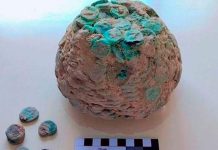Xolos are one of the world’s oldest ancient dog breeds, originally from Mexico. Huge ears, a hairless appearance, and a beautiful, regal body define this Mexican breed. It is considered a national treasure in its own country and is one of the oldest dog breeds. These hairless dogs are found in standard, intermediate, and miniature sizes, but they also come in a coated variety, entirely covered in fur.
Xolos share DNA with prehistoric dog breeds, making them the closest surviving cousins of ancient canines today. The first tales of Xolo dogs date back over 4000 years to the Aztec Empire. The Ancient Mayans called the dogs Xolotl, and held them in great regard in their society. The Xolotl is frequently represented in art with a dog’s head and was thought to guide souls to the underworld.
He is claimed to have created Xolo dogs to send to the mortal realm for mankind. The Mayans and other tribes thought that Xolos would guide people to the afterlife, and archaeological searches have revealed Xolo skeletons, collars, a dog bowl, and even pottery figurines of the canines in ancient graves.
Some people in Mexico still think that if you are harsh to a dog while alive, Xolos will refuse to let you cross the right path. Since Xolos originated in tropical regions, they are better suited for indoor environments in colder temperate and northern climates.
Aside from its sacred and ritual significance, the Aztecs utilized Xolos for hunting, guarding, and sentry duties. Xolos were also given to other tribes for diplomatic purposes and to alleviate food shortages among tribes. They, along with turkeys, were the only domesticated animals that the Aztecs frequently ate. The first European tales of Xolos date back to the 16th century, when legendary explorer Christopher Columbus wrote about “weird, hairless dogs” he saw wandering with Aztecs during his voyage to the New World.
Spanish conquistadors who came to Mexico also wrote of the dog’s intimate relationship with indigenous people, mentioning how Aztecs would wrap Xolos in blankets and nestle them in with youngsters on cold evenings. Dog meat intake initially offended invaders, but they soon developed a liking for the animal. This period marked the start of a tumultuous period in Xoloitzcuintli’s history, which nearly resulted in its extinction.
Spanish conquistadors, who brought with them a desire to spread Christianity, despised the Aztecs’ spiritual rituals, which led to the Xolo’s demise. The dogs were swiftly devoured by the newcomers, and cross-breeding between Xolos and European dog species imported by the invaders, such as Dachsunds and Poodles, significantly reduced their numbers. By the early nineteenth century, the few remaining Xolos might be found in remote mountain village communities. Despite the fact that the American Kennel Club recognized the breed in the late 18th century and a Xolo won an AKC champion title in the 1940s, little effort was made to restore it.
However, the breed would find itself at the center of a new movement in its hometown. Following the 1910 Mexican Revolution, the country tried to reinforce its national identity by increasing interest in Indigenous arts and culture. The Xolo is often less prone to health and structural issues than other dog breeds that have undergone more modifications through human selection because it has evolved naturally over thousands of years. The demeanor of the Xoloitzcuintle is calm and alert.
Famous Mexican artists like Frida Kahlo and Diego Rivera appreciated the humble behavior of Xolso, incorporating the distinctive dogs into several of their paintings. With its popularity comes a wish to conserve the breed. In the 1950s, an expert team scoured Mexico for the last remaining Xolos, eventually settling on ten dogs to help revive the breed.
Read More: Mutt is the brave French Bulldog of WWI







